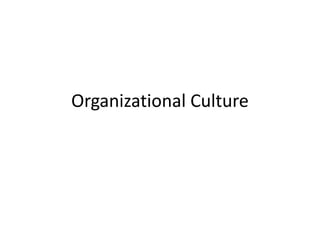
Org. culture,1
- 2. • Organizational culture is the behavior of humans who are part of an organization and the meanings that the people attach to their actions. Culture includes the organization values, visions, norms, working language, systems, symbols, beliefs and habits. It is also the pattern of such collective behaviors and assumptions that are taught to new organizational members as a way of perceiving, and even thinking and feeling. Organizational culture affects the way people and groups interact with each other, with clients, and with stakeholders.
- 3. • Ravasi and Schultz (2006) state that organizational culture is a set of shared mental assumptions that guide interpretation and action in organizations by defining appropriate behavior for various situations. At the same time although a company may have their "own unique culture", in larger organizations, there is a diverse and sometimes conflicting cultures that co-exist due to different characteristics of the management team. The organizational culture may also have negative and positive aspects.
- 4. • Schein (2009), Deal & Kennedy (2000), Kotter (1992) and many others state that organizations often have very differing cultures as well as subcultures. • Organizational culture refers to culture in any type of organization be it school, university, notfor-profit groups, government agencies or business entities. In business, terms such as corporate culture and company culture are sometimes used to refer to a similar concept.
- 5. • Atkinson explains org.l culture as reflecting the underlying assumption about the way work is performed; what is acceptable and not acceptable; and what behaviour and actions are encouraged and discouraged. • A more detailed definition could be : the collection of traditions, values, policies, beliefs, and attitudes that constitute a pervasive context for everything we do and think in an org. • Culture is reinforced through the system of rites, and rituals, patterns of communication, the informal org, expected patterns of behaviour and perceptions of the psychological contract.
- 6. Levels of Culture Schine suggests a view of org.l culture based on distinguishing three levels of culture: 1. Artefacts 2. Values 3. Basic Underlying Assumptions
- 7. Level-1: Artefacts The most visible level of the culture is artefacts and creations – the constructed physical and social environment. This includes physical space and layout, the technological output, written and spoken language and the behaviour of group members.
- 8. Level – 2: Values Cultural learning reflects someone’s original values. Solutions about how to deal with a new task, issues or problems are based on convictions of reality. If the solution works the value can transform into a belief. Values and beliefs become part of the conceptual process by which group members justify actions and behaviour.
- 9. Level-3: Basic Underlying Assumptions When a solution to a problem works repeatedly it comes to be taken for granted. Basic assumptions are unconsciously held learned responses. They are implicit assumptions that actually guide behaviour and determine how group members perceive, think and feel about things. Schein suggests that the basic assumptions are treated as the essence – what culture really is, and values and behaviors are treated as observed manifestations of the cultures essence.
- 10. Types of Organizational Culture According to Harrison and Handy there are four main types of org.l cultures: 1. Power culture 2. Role Culture 3. Task Culture 4. Person Culture
- 11. 1. Power Culture power culture depends on a central power source with rays of influence from the central figure throughout the org. A power culture is frequently found in small entrepreneurial org.s and relies on trust, empathy and personal communications for its effectiveness. Control is exercised from the centre by the selection of key individuals. There are a few rules and procedures, and little bureaucracy. It is a political org with decisions taken largely on the balance of influence.
- 12. 2. Role Culture Role Culture is often stereotyped as a bureaucracy and works by logic and rationality. Role culture rests on the strength of strong org.l pillars – the functions of specialists in, for example, finance, purchasing and production.
- 13. 3. Task Culture Task culture is job-oriented or project oriented. It seeks to bring together the right resources and people, and utilities the unifying power of the group. Influence is widely spread and based more on expert power than on position or personal power.
- 14. 4. Person Culture Person Culture is where the individual is the central focus and any structure exists to serve the individuals within it. When a group of people decide that is in their own interests to band together to do their own thing and share office space, equipment or clerical assistance then the resulting organization would have a person culture. Ex: group of barristers, architects, doctors or consultants, etc. Although it is found in only a few org.s many individuals have a preference for person culture. Ex: university professors. Management hierarchies and control mechanisms are possible only by mutual consent. Individuals have almost complete autonomy and any influence over them is likely to be on the basis of personal power.
- 15. • Every org will have its own unique culture and most large businesses are likely to be something of a mix of cultures with examples of each of the four types in varying areas of the org. • Different people enjoy working in different types of org culture and they are more likely to be happy and satisfied at work if their attributes and personalities are consistent with the culture of that part of the org in which they are employed.
